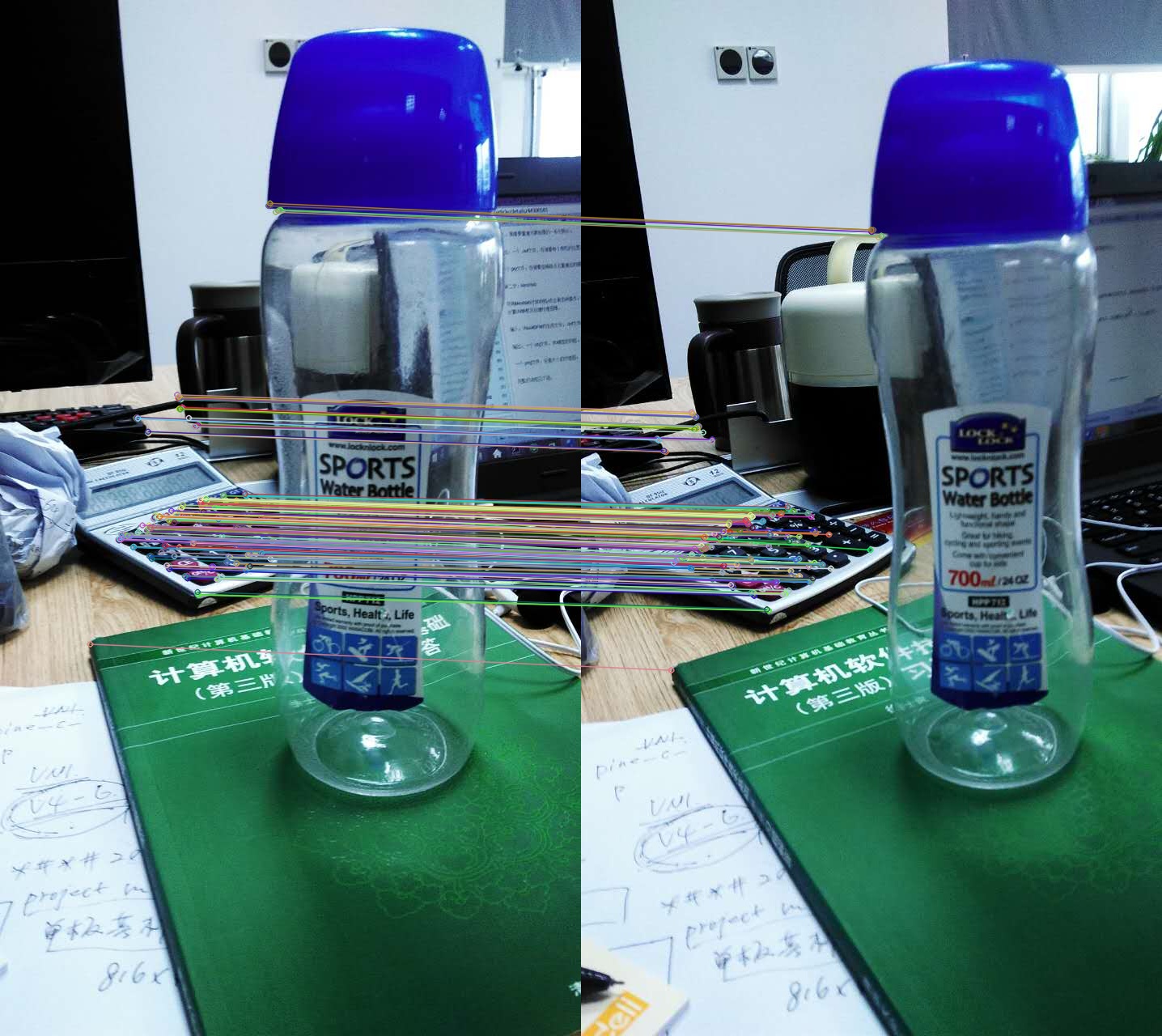Opencv 各種特徵點提取和匹配
opencv 特徵點的提取和匹配
1. 當中的資料結構
KeyPoint這資料結構中有如下資料結構:
class KeyPoint
{ Point2f pt; //座標
float size; //特徵點鄰域直徑
float angle; //特徵點的方向,值為[零,三百六十),負值表示不使用
float response;
int octave; //特徵點所在的影象金字塔的組
int class_id; //用於聚類的id
angle:角度,表示關鍵點的方向,SIFT演算法通過對關鍵點周圍鄰域進行梯度運算,求得該點方向。-1為初值。
class_id:當要對圖片進行分類時,我們可以用class_id對每個特徵點進行區分,未設定時為-1
octave:代表是從金字塔哪一層提取的得到的資料。
pt:關鍵點點的座標(pt.x pt.y)
response:響應程度,代表該點強壯大小。response代表著該關鍵點how good,更確切的說,是該點角點的程度。瞬間明白。
size:該點直徑的大小
注意:keypoint只是儲存了opencv的sift庫檢測到的特徵點的一些基本資訊,也就上面所說的這些,但sift所提取出來的特徵向量其實不是在這個裡面,特徵向量通過SiftDescriptorExtractor 提取,結果放在一個Mat的資料結構中。新版的SIFT可以直接提取。
DMATCH 資料結構:
struct DMatch
{ //三個建構函式
DMatch():
queryIdx(-1),trainIdx(-1),imgIdx(-1),distance(std::numeric_limits::max()) {}
DMatch(int _queryIdx, int _trainIdx, float _distance ) :
queryIdx( _queryIdx),trainIdx( _trainIdx), imgIdx(-1),distance( _distance) {}
DMatch(int _queryIdx, int _trainIdx, int _imgIdx, float _distance ) :
queryIdx(_queryIdx), trainIdx( _trainIdx), imgIdx( _imgIdx),distance( _distance) {}
int queryIdx; //此匹配對應的查詢影象的特徵描述子索引(輸入圖1)
int trainIdx; //此匹配對應的訓練(模板)影象的特徵描述子索引(輸入圖2)
int imgIdx; //訓練影象的索引(若有多個)
float distance; //兩個特徵向量之間的歐氏距離,越小表明匹配度越高。
booloperator < (const DMatch &m) const;
};
2. 各種的特徵點
SIFT SURF FAST。。。。
使用特徵提取過程得到的特徵描述符(descriptor)資料型別有的是float型別的,比如說:surf SurfDescriptorExtractor,sift
SiftDescriptorExtractor,有的是uchar型別的,比如說有ORB,BriefDescriptorExtractor。
對應float型別的匹配方式有:FlannBasedMatcher,BruteForce等。對應uchar型別的匹配方式有:BruteForce,BruteForce。所以ORB和BRIEF特徵描述子只能使用BruteForce匹配法。 #include opencv2/legacy/legacy.hpp>
在連結選項當中加入: opencv_legacy248d.lib (release版本的就是: opencv_legacy248.lib 248 換成你的版本號)
在連結選項當中加入: opencv_legacy248d.lib (release版本的就是: opencv_legacy248.lib 248 換成你的版本號)
具體的程式碼如下:
#include <iostream>
#include "opencv2/opencv.hpp"
#include "opencv2/core/core.hpp"
#include "opencv2/features2d/features2d.hpp"
#include "opencv2/highgui/highgui.hpp"
#include "opencv2/legacy/legacy.hpp" // 暴力匹配的標頭檔案
#include "opencv2/nonfree/nonfree.hpp"
#include <iostream>
#include <vector>
#include "cv_import_static_lib.h"
using namespace std;
using namespace cv;
void main(){
Mat img_1 = imread("E:\\3Dtestdata\\3.jpg");
Mat img_2 = imread("E:\\3Dtestdata\\4.jpg");
if (!img_1.data || !img_2.data)
{
cout << "error reading images " << endl;
return ;
}
vector<KeyPoint> keyPoints_1, keyPoints_2;
Mat descriptors_1, descriptors_2;
/*-----------------SIFT featrue Point----------------
SIFT sift;
sift(img_1, Mat(), keyPoints_1, descriptors_1);
sift(img_2, Mat(), keyPoints_2, descriptors_2);
*/
/*-----------------SURF featrue Point----------------
SURF surf;
surf(img_1, Mat(), keyPoints_1, descriptors_1);
surf(img_2, Mat(), keyPoints_2, descriptors_2);
//SurfDescriptorExtractor extrator; // another surf sift operation
//extrator.compute(img_1, keyPoints_1, descriptors_1);
//extrator.compute(img_2, keyPoints_2, descriptors_2);
*/
//-----------------ORB featrue Point----------------
ORB orb; // float Feature, can not use FlannBase Match.
orb(img_1, Mat(), keyPoints_1, descriptors_1);
orb(img_2, Mat(), keyPoints_2, descriptors_2);
/*-----------------ORB featrue Point----------------
MSER mesr;
*/
/*-----------------FAST featrue Point----------------
FastFeatureDetector fast1(100); // 檢測的閾值為40
FastFeatureDetector fast2(100);
fast1.detect(img_1, keyPoints_1);
fast2.detect(img_2, keyPoints_2);
//SurfDescriptorExtractor extrator; // another surf sift operation
//extrator.compute(img_1, keyPoints_1, descriptors_1);
//extrator.compute(img_2, keyPoints_2, descriptors_2);
OrbDescriptorExtractor extrator;
extrator.compute(img_1, keyPoints_1, descriptors_1);
extrator.compute(img_2, keyPoints_2, descriptors_2);
*/
BruteForceMatcher<HammingLUT> matcher;// orb 等float型的
//FlannBasedMatcher matcher; // 只能 對uchar的點進行匹配
vector< DMatch > matches;
matcher.match(descriptors_1, descriptors_2, matches);
double max_dist = 0; double min_dist = 100;
//-- Quick calculation of max and min distances between keypoints
for (int i = 0; i < descriptors_1.rows; i++)
{
double dist = matches[i].distance;
if (dist < min_dist) min_dist = dist;
if (dist > max_dist) max_dist = dist;
}
cout<<"-- Max dist :"<< max_dist<<endl;
cout<<"-- Min dist :"<< min_dist<<endl;
//-- Draw only "good" matches (i.e. whose distance is less than 0.6*max_dist )
//-- PS.- radiusMatch can also be used here.
vector< DMatch > good_matches;
for (int i = 0; i < descriptors_1.rows; i++)
{
if (matches[i].distance < 0.6*max_dist)
{
good_matches.push_back(matches[i]);
}
}
// vector<KeyPoint> m_LeftKey;
// vector<KeyPoint> m_RightKey;
// vector<DMatch> m_Matches;
// 以上三個變數已經被計算出來,分別是提取的關鍵點及其匹配,下面直接計算F
// 分配空間
int ptCount = (int)matches.size();
Mat p1(ptCount, 2, CV_32F);
Mat p2(ptCount, 2, CV_32F);
// 把Keypoint轉換為Mat
Point2f pt;
for (int i = 0; i<ptCount; i++)
{
pt = keyPoints_1[matches[i].queryIdx].pt;
p1.at<float>(i, 0) = pt.x;
p1.at<float>(i, 1) = pt.y;
pt = keyPoints_2[matches[i].trainIdx].pt;
p2.at<float>(i, 0) = pt.x;
p2.at<float>(i, 1) = pt.y;
}
// 用RANSAC方法計算 基本矩陣F
Mat m_Fundamental;
vector<uchar> m_RANSACStatus;
m_Fundamental = findFundamentalMat(p1, p2, m_RANSACStatus, FM_RANSAC);//?????????????????
// 計算野點個數
int OutlinerCount = 0;
for (int i = 0; i<ptCount; i++)
{
if (m_RANSACStatus[i] == 0) // 狀態為0表示野點
{
OutlinerCount++;
}
}
// 計算內點
vector<Point2f> m_LeftInlier;
vector<Point2f> m_RightInlier;
vector<DMatch> m_InlierMatches;
// 上面三個變數用於儲存內點和匹配關係
int InlinerCount = ptCount - OutlinerCount;
m_InlierMatches.resize(InlinerCount);
m_LeftInlier.resize(InlinerCount);
m_RightInlier.resize(InlinerCount);
InlinerCount = 0;
for (int i = 0; i<ptCount; i++)
{
if (m_RANSACStatus[i] != 0)
{
m_LeftInlier[InlinerCount].x = p1.at<float>(i, 0);
m_LeftInlier[InlinerCount].y = p1.at<float>(i, 1);
m_RightInlier[InlinerCount].x = p2.at<float>(i, 0);
m_RightInlier[InlinerCount].y = p2.at<float>(i, 1);
m_InlierMatches[InlinerCount].queryIdx = InlinerCount;
m_InlierMatches[InlinerCount].trainIdx = InlinerCount;
InlinerCount++;
}
}
// 把內點轉換為drawMatches可以使用的格式
vector<KeyPoint> key1(InlinerCount);
vector<KeyPoint> key2(InlinerCount);
KeyPoint::convert(m_LeftInlier, key1);
KeyPoint::convert(m_RightInlier, key2);
// 顯示計算F過後的內點匹配
//Mat m_matLeftImage;
//Mat m_matRightImage;
// 以上兩個變數儲存的是左右兩幅影象
Mat OutImage;
drawMatches(img_1, key1, img_2, key2, m_InlierMatches, OutImage);
//stereoRectifyUncalibrated();
Mat img_matches;
drawMatches(img_1, keyPoints_1, img_2, keyPoints_2,
good_matches, img_matches, Scalar::all(-1), Scalar::all(-1),
vector<char>(), DrawMatchesFlags::NOT_DRAW_SINGLE_POINTS);
imwrite("FASTResult.jpg", img_matches);
imshow("Match", img_matches);
imwrite("FmatrixResult.jpg", OutImage);
imshow("Match2", OutImage);
waitKey(0);
return;
}做好匹配以後,對於以後的三維重建都很有幫助。

